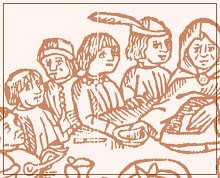Sadly, my citations are being uncooperative, so there will be no Edward II essay tonight.
One of the slightly unfortunate sides of writing an essay on Edward II for a course called "The Mediaeval Body" is that it does, inevitably, involve reading a lot of queer and gender criticism. This is only slightly unfortunate because a lot of it is absolutely fascinating. It is slightly unfortunate because I find it very difficult to read a lot of it at once. Like any critical approach with a specific agenda to push, it can become very esoteric and self-absorbed, and often over-states itself. It's also prone to hyperactive political correctness and consequent over-definition of terms, or an abundance of terms that mean almost the same thing but not quite (my current favourite is "non-heternormative").
I picked up a collection of essays from the university library, in preparing for this essay, called Sodomy in Early Modern Europe[1]. It's after the time I'm looking at, of course, but one of the essays mentions Edward II retrospectively, and it was an interesting and generally well-written collection anyway. But one feature that particularly struck me was that the author of each chapter had to redefine the word 'sodomy', according to what it meant not only in the time and place he or she was studying, but how he or she intended to use it in this chapter. Mostly it was some form of sex between two men, sometimes other not-quite-normal sex acts that we wouldn't raise an eyebrow at nowadays, with occasional hints of child sexual abuse and one slightly bewildering chapter on bestiality in Scotland. I don't believe I've ever read a collection in which the key term of enquiry was redefined quite so extensively from one chapter to the next.
Of course, it makes a valid point. Sodomy was defined differently in different times and places throughout mediaeval and modern Europe, and even today there are places where it can mean anything that isn't heterosexual marital missionary-position vaginal sex for the purposes of procreation. Generally speaking, it was a term of appalled repulsion at the idea of transgressing sexual norms. But that raises the question, unaddressed in that book or any other that I've noticed yet, of just what those norms are. And that leaves a good deal not explored or fully understood about the nature of what is not normal, how a society defines it and deals with it, tries to incorporate it, exclude it, ignore it, overwrite it, anything. If we define black as "not white" that tells us very little about black until we've explored just what "white" means for us as well. And I think this is, in the end, a very likely pitfall for any of these specifically "issues"-based fields of criticism or enquiry.
I say all this, of course, from the privileged position of a not-entirely-straight woman who stands on the far side of the feminist and gay rights movements. I certainly don't mean to deny the value of these perspectives - it's important that we are able to look back and consider history and literature from all these points of view. I do think, though, that in the end we'll know the case is won when rather than saying "queers are evil!" or "celebrate being gay, it is wonderful!" we can honestly say "yes, that's part of this, but actually it doesn't matter all that much".
[1] Actually, SODOMY in Early Modern Europe. I did notice that as a feature of the queer studies shelves - an awful lot of books seemed to have a single, rather explicit word or phrase in very large eye-catching letters on the jacket, usually in very bright colours, followed by the rest of the title in self-effacing little letters. Call me odd, but I don't think a good book really needs to advertise itself like that - but maybe the editors don't agree.
Sodomy in Early Modern Europe is edited by Tom Betteridge (New York: Manchester UP, 2002).
2 weeks ago


.jpg)


No comments:
Post a Comment